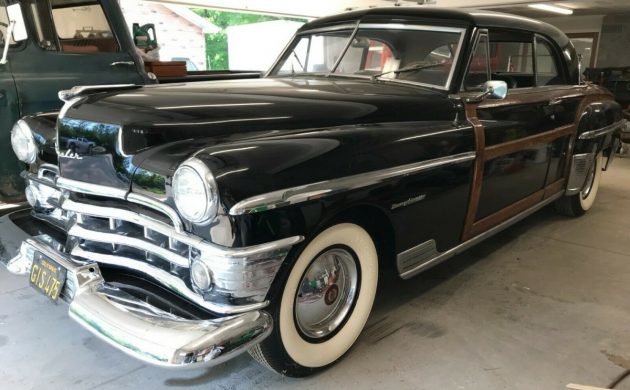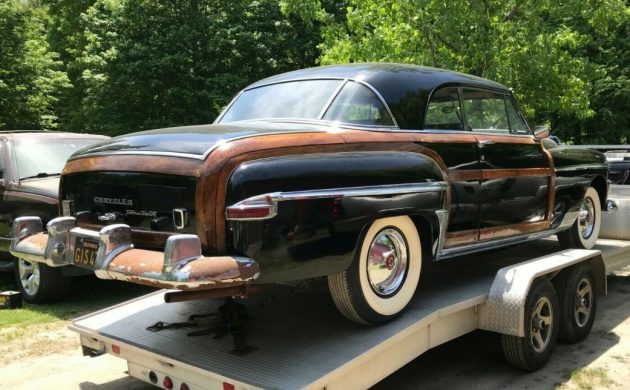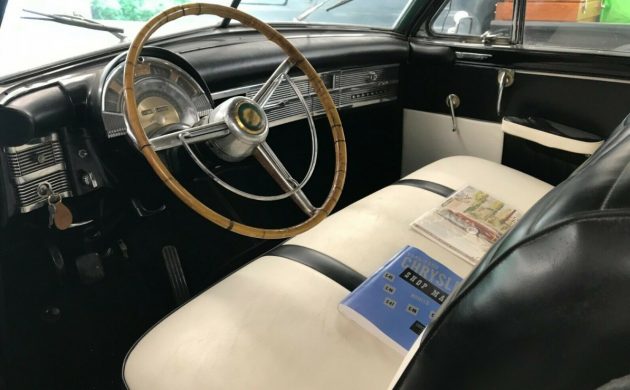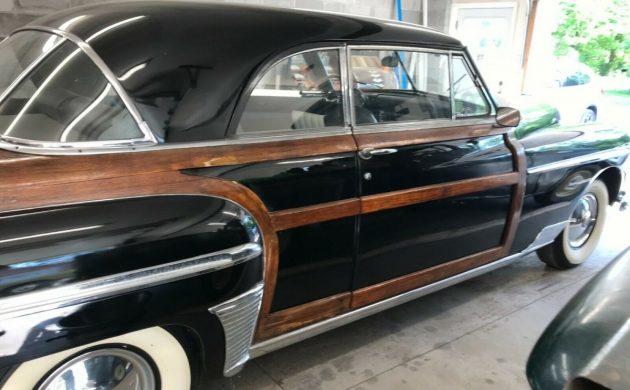Now, here’s a very, very nice surprise in the form of a 1950 Chrysler Town & Country Newport hardtop discovered by Larry D. I have seen plenty of Town & Country examples from this era but never one wearing a hardtop body design. Claimed to be one of less than 700 produced, this magnificent Chrysler is located in Amenia, New York and is available, here on eBay for a BIN price of $22,499. There is a make an offer option too.
As it turns out, 1950 was the end of the line for true woodies at Chrysler and beautiful hand-formed ash would be used no more. The wood trim application is tasteful though it’s not quite as extensive as one would find on a woodie wagon. Nevertheless, it’s certainly not a styling effect that would be overlooked either. And it all looks to be in pretty good shape. There is some delamination occurring but none of the cellulose-based trim appears to be rotted. The finish, which could be the original enamel or lacquer paint job, is quite deep and consistent on this 64K mile coupe. There is no mention if any, or all of the finish is a redo. Whichever the case, it all still looks great though the rear bumper is going to need some attention – it’s more rust than chrome at this point. The extensive trim appears to all still be in place but age and weather have dulled its luster a bit. One of the most notable styling features of this Chrysler is the flow of the c-pillars in concert with the three-pane backlight – it’s high style!
Power is provided a 135 gross HP, 323 CI, in-line, flathead, straight eight-cylinder engine. The seller claims, “The Town and country starts easily, runs great, and has been tuned up. Needs brake work in order to be driven“. Speaking of the brakes, there is a mention of the inclusion of disc brakes, a feature that would seem out of place on a mid-century domestic coupe. According to Hemmings, the disc brake design is not what one might think as they are described as such: “These brakes did not incorporate a caliper clamping down on a disc; instead, they relied on the engagement of a pair of discs rubbing against the inside surface of a cast-iron drum. I’d call that a true disc-drum setup, but not a disc brake“. The transmission is what’s known as a “Fluid Drive” gearbox which was an automatic/manual hybrid unit that utilized a clutch pedal to get moving but not needed for gear changing.
The interior with its two-tone black and white upholstery might be the biggest surprise of all. It is in fantastic shape, I’d suggest too fantastic to be original. The seller refers to it as being “very presentable” but I’d posit that it’s better than that. The instrument panel is more restrained than some cars from this era but it’s in fine condition. Unfortunately, the steering wheel has lost some rim “chunks” and the radio is missing.
This Chrysler Town & Country Newport is truly a fine automobile. It’s hard to imagine a time when such craftsmanship and style were melded into a regular production automobile. Sure, it was expensive for the time ($4,028), as the seller states, but not as ridiculously out of line as near-bespoke cars are today. I’m afraid to say, we won’t see the likes of this 1950 Chrysler T&C Newport again. So tell me, has anyone owned a true “woodie” and if so, how difficult is it to maintain and/or replace the wood trim?





Wow that thing is cool. I’m not a big fan of the ’50-’52 Detroit cars, but this one is really sharp, especially in black.
Last year’s of craftsman working on cars. Fitting wood to automobiles was ending. Even boats as by the early 50’s fiberglass made it’s way into both industries. Can’t quite get my head wrapped around how hard mainting a wood finish on these wonderful cars would have been. What happened when these cars ( woodies) if the were damaged in a traffic accident? Can’t just straighten out broken wood. I’m an older guy but not that old.
Former father-in-law had one. It was only driven on sunny days.
I was with him when he had to drive through a orchard sprinkler. He (f-in-l) stopped the car, jumped out and thoroughly dried where the car was wet. He was frantic in drying it off as quickly as possible.
We immediately drove home where he dried it some more, started his air compressor to drive out any moisture and soaked up any remaining moisture.
In retrospect, he should have spent more time dissuading his daughters away from narcissism.
Sweet…..Diggin up bones. Car and family. Maybe therapy?
Not quite as far as Armenia, but this beautiful car is in a beautiful Hudson Valley town of Amenia.
I wanted to see if you were paying attention… (fixed, thx).
JO
And then there’s me, in the state of Anemia.
At least its not in the state of asphyxia.
At the bottom of the description page it says:
Terms of Sale:
——————–
-This is a no reserve auction – highest bid wins
Confusing, left over from another listing?
The clutch on a fluid-drive car was just to switch from low to high on the “semi-automatic” versions or to shift between gears on the manual version. The fluid-drive could be stopped or started in any gear without pressing the clutch pedal.
A great car. Fluid drive was smooth but slow on the uptake, but so was the Buick’s Dynaflow and the original Chevy Powerglide. If you wanted quickness off the line, you got an Olds or a Ford/Mercury with a standard transmission.
The ‘disc’ brake system was like the Lockheed system on planes, or the New Departure system on the bicycle coaster brakes of the time, metal discs pushed together, and on this against the drum.
Some infos about the Ausco-Lambert “discs” brakes : https://www.web.imperialclub.info/Repair/Brakes/lambert.htm
From the factory these Chrysler woodies wood were finished in a marine grade varnish. I recall in my youth the local Imperial wizard (cars not clan) had several of the ’40-50’s wooden Chryslers in varies states of decay, but the guy had over 200 Imperials and other rare Chryslers. He did have several of the Town and Country convertibles and they were fascinating cars to look at. The construction was so interesting and he explained that the furniture makers that fabricated them had to account for a wide range of issues when building them, temperature, humidity, differing thermal coefficients of wood on metal. He was such a wealth of knowledge, .There was a time when these were reach the $100+K mark but I suspect most of those buyers are in retirement homes or pushing daisies…….
As a woodie owner (1952 Buick Roadmaster) I can share that my original owners manual told the new owner to bring in his or her woodie to the dealership once a year to have the wood sanded and re-varnished. Hard to imagine the range of skills that were probably pretty common in car service shops back in this era. Back then they actually tin knocked out dents rather than slapping on a replacement.
SteveO
I’ve owned three woodies and one right now – unfortunately wooden bodied cars in general are on a downturn as mentioned by others (a good barometer is the 49-51 shoebox ford woodies). This one is priced probably a little high at the moment depending on how bad the body is and if the wood is needing bleaching or decayed/dry rotted to the point of requiring replacement. Very expensive to have new wood made.
And, I almost forgot, I was a woodie owner, 45 years ago, a memory so bad I erase it from time to time. I was teaching at the college level, a student who was into cars, told me after class that he had found a ’40 Ford standard woodie, for $75. It was a woods find in NH. Sheet metal was all there, and in pretty good shape, floor was mostly gone. Front and back seats were sort of there. No engine or transmission, but those are easily obtained, even now. And wood, lots of wood, lots of good wood, and lots of rotten wood. But all there. Roof slats mostly there, canvas mostly there. Towed it home with my ’67 Bonneville. 3 year old son cried. “It’s all broken,” he said. Wife’s friend said, “At least it is not another woman.” It went into my garage and sat for 2 years. It was obviously beyond my skills or budget, listed it in the NH old car paper, sold it for $225 to a guy for parts, wood and metal, for his.
Fluid drive! Awesomely interesting to drive. Once up to speed this car will float you to your destination with quiet , smooth ride. Lotsa’ fun left in this one! Just rechrome a bumper, restore the steering wheel, find a correct radio and go!
I really wonder how that bumper attracted so much rust. There must be a story there. The rest of the car appears to be close to mint. So the bumper really stands out like that proverbial sore thumb.
1950 saw the US return to war, this time in Korea. That meant restrictions on various materials, including copper and nickel, both necessary in the Chrome plating process over steel. Chromium doesn’t stick well to steel, but it sticks great to copper. Problem is, copper and steel don’t bind well, but nickel binds to both copper and steel. Hence this is what is referred to as “triple plated chrome”.
Many cars built between early 1950 and 1952 skipped the copper and nickel process, and eventually the chrome will peel off in sheets, as seen on this bumper.
Sometimes, less than honest chrome bumper plating companies would skip the triple plating, knowing the chrome would last long enough to make it thru the 1 year warranty for most auto body shops that did accident repairs, so this car might have been a victim of a cheap chrome plating job 40 years ago.
But my bet is on a simple war restriction that impacted all the US car companies. the 1951 – 52 Packard is a perfect example. All the pot metal castings that got chrome plating in those years were also painted with clear lacquer paint to help it hold up better, but eventually the paint wears off and the pot metal pits like crazy. Finding original ’51-’52 Packard pot metal trim is next to impossible, and has been this way since the early 1960s.
I had an exact sister to this car, but in dark green. Found it in a barn in Olney, Maryland in about 1970. It was stored next to 2 other cars, a 1951 Packard Convertible, and to it’s right side, a 1955 Buick Roadmaster sedan with factory A/C. All 3 cars belonged to an elderly lady. I used to visit her and the cars on a regular basis. I wanted the Packard, but as always they were not for sale.
On her death I was contacted by her son. This was about 1982. Seems she willed the 3 cars to me. The property of about 200 acres had been sold to a developer and the cars needed to be gone within about 6 months. Anything remaining after the final date would be scrapped. I pulled the Packard out of the barn first, then the Chrysler, only to find it was badly eaten by termites that had run their tubes from the barn siding to the wood in the decklid That decklid fell apart when I tried to raise it.
I pulled the trunk A/C and compressor, then flipped the Buick onto it’s side and pulled all the A/C lines from alongside the frame. I had a 1957 Packard Clipper that used the same basic A/C trunk unit and air ducting in the rear package shelf, and sold the compressor to a local Cadillac guy. I stuck the A/C in the Packard, and finally had A/C in my everyday car.
Ended up selling the Packard to a collector in Mass, as it needed more attention than I was prepared to give. A friend of mine’s father was the Ambassador to the US from Portugal, and he said he could ship it back to Portugal, where they had guys who could rebuild the entire car including the wood body, and for far less than the USA restoration costs. As he loaded up the Chrysler, that’s the last I ever saw of it. I hope he was able to get the car restored. Somewhere there may well be a 1950 Chrysler Newport hardtop running around the Iberian peninsula!
Wow…. class personified ! Price seems rather fair for a Woody. Seems like a straight forward project. Very tempting !!
Back in 1968 when I was 14 growing up in Santa Monica CA, some close friends of my parents were moving up to Bainbridge Island, WA. I drove up with them to help them move into their home. We stayed the night in Medford Oregon on the way up. This was my first time out of California. In the morning I saw an older man who was around 80 with a car identical to this one in the hotel parking lot wiping it down with what I believe to be a dust buster. I spent a half hour or so talking to him about how he bought it brand new. He was very friendly and was pleased that I had an interest in cars. He. encouraged me to complete school and then college, and to seek a career in the auto industry. He also liked that I thought his car was so cool. I have thought of my conversation with him over the years and wished I could have contacted him years later to let him know that I did follow his advice and finished college, and then spent over 40 years working for an American automotive manufacturer. This is the first time that I’ve seen a car just like his since that day.
Thanks Bill for your post on the chrome process during the war years. It was very informative, I enjoyed it.
Rex,
This comes from 30+ years running a restoration shop, and figuring out what it takes for suppliers to provide the best products, because my customer can care less about what the chrome shop or machine shop screwed up.
For years I dealt with plating shops that promised the world, and after paying them before getting the parts shipped back, what I received back was sub-par. I would estimate that probably half of the small plating shops who offer vintage vehicle plating services, don’t have a clue how to fill pits on pot metal parts without grinding the hell out of the part, losing all the intricacies of the piece.
So when I can explain the process that creates a truly great product, I want to make sure everyone understand what it takes.
40 years ago I had trouble finding a company to make small runs of machined chrome emblems here in America. I finally found a small dirt floor shop with antiquated machine tools and a 100 year old forge & smelter, but they were able to provide beautiful products at a good price, because they were dedicated to producing the best. It was a family run organization in Pakistan, with 3 generations of family making my parts.
For a resto shop plating is the worst thing to deal with!!!